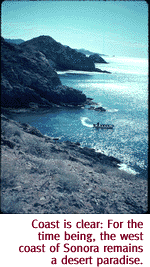
Whales Frolic Where The Desert Meets The Sea.
By Kevin Franklin
THOSE AREN'T WHALES, I think. But the powerful resonance
of a marine mammal exhaling through its blowhole again reaches
my ears. I strain to see through the twilight.
 The sun set nearly an hour ago. Even with the magnification of
a monocular, I can barely make out indistinct humps gliding through
the darkening water.
The sun set nearly an hour ago. Even with the magnification of
a monocular, I can barely make out indistinct humps gliding through
the darkening water.
The mammals continue moving south, just off this secluded cove
on the west coast of Sonora, Mexico. The light is such that they
appear midway between the beach and the horizon. With no point
of reference, the objects could be five- or 50-feet-long.
In all my years living on the Atlantic Seaboard and roaming the
beaches of Mexico, I've never seen a live whale. But nearly every
trip to the Sea of Cortez, I've seen dolphins. Almost by force
of habit I judge these to be the same. Yet that sound seems too
deep and, while difficult to judge, the bodies seem large next
to the small waves. I hope they are whales.
The mystery remains unresolved as twilight turns to total blackness.
I crawl into my sleeping bag and drift off, listening to large
creatures moving nearby in a dark sea.
Our little group is camped in the heart of the Cajón del
Diablo Biosphere Reserve. This stretch of coastline, south of
Kino Bay and north of Guaymas, could be the best place on Earth--at
least for an Ocean-loving desert rat. Here the grand columnar
cactus and rugged, mostly empty terrain of the Sonoran Desert
meet the Sea of Cortez. Multicolored volcanic ash flows, long
since hardened to jagged rock, reach into the sea like fantastic
taffy mountains. Dolphins are visible by day and coyotes heard
by night. Beneath the water's surface, one of the world's narrowest
seas invites submersible explorers into an environment as teeming
with life as its terrestrial neighbor is sparse.
May God preserve it from the greed of gringo developers and the
ignorance of Mexican fishermen.
 Upon arrival in this secluded little cove, we picked up three
bags of garbage, mostly Mexican candy wrappers, diapers and picnic
junk. Oil filter gaskets were regularly interspersed with the
assorted garbage. Apparently, when the fishermen working the coastline
change their boat oil, they toss the oil-soaked filters overboard.
Presumably the old oil goes with it.
Upon arrival in this secluded little cove, we picked up three
bags of garbage, mostly Mexican candy wrappers, diapers and picnic
junk. Oil filter gaskets were regularly interspersed with the
assorted garbage. Apparently, when the fishermen working the coastline
change their boat oil, they toss the oil-soaked filters overboard.
Presumably the old oil goes with it.
How someone with his livelihood so closely tied with the health
of the sea could be so stupid pains me.
Perhaps there's some glimmer of hope in the 15 miles of coastline
falling under the protection of the Cajón del Diablo reserve.
These reserves are different than U.S. National Parks, or even
National Forests. People live and work within them, much as they
always have. The idea is that by keeping people in their homes
and continuing the extraction of natural resources, while managing
them with long-term sustainability in mind, both the environment
and mankind can flourish. A cynic might note that with little
enforcement or oversight, the designations add color to maps while
signifying nothing. With examples of complete ignorance like the
tideline's plethora of gaskets, I find optimism an elusive quality.
Nevertheless, life still teems here. What sounds like a distant
waterfall rouses me from sleep in the early morning. About a quarter
mile offshore, birds are falling from the sky. Like marbles out
of a bag, a dozen brown and maybe blue-footed boobies dive into
the sea in search of breakfast. There must be more than a thousand
birds in the sky.
But more stunning than the sheer quantity of bird life is the
apparent organization of these hunters of small fish. Perhaps
50 feet off the water's surface, all the birds are circling counterclockwise
in an oval pattern half the size of a football field. After completing
one circuit, each bird dives out of the sky into the aquatic target
area. At any given moment, a dozen birds are hitting the water,
creating the waterfall-like sound. Then they lift off fish-in-beak,
if they're lucky, to rejoin the flock circling above.
Dozens of dolphins ring in behind the school of fish, forcing
them to the surface.
Later in the day I hike down the coast. In the distance what
looks like smoke erupts from the sea. With the advantage of daylight,
we finally determine they are indeed whales. More than a mile
out to sea, they're impossible for a layman like me to identify.
But my wish for whales has been answered. I only hope my dreams
for the continued integrity of Sonora's coastline find equal footing
in the real world.
GETTING THERE
Take I-19 south to the Mexican border, continuing south on Highway
15 about 55 miles past Hermosillo. Follow the paved road northwest
for about 15 miles until you see the sign for San Augustín.
Follow the dirt road to the coast.

|
